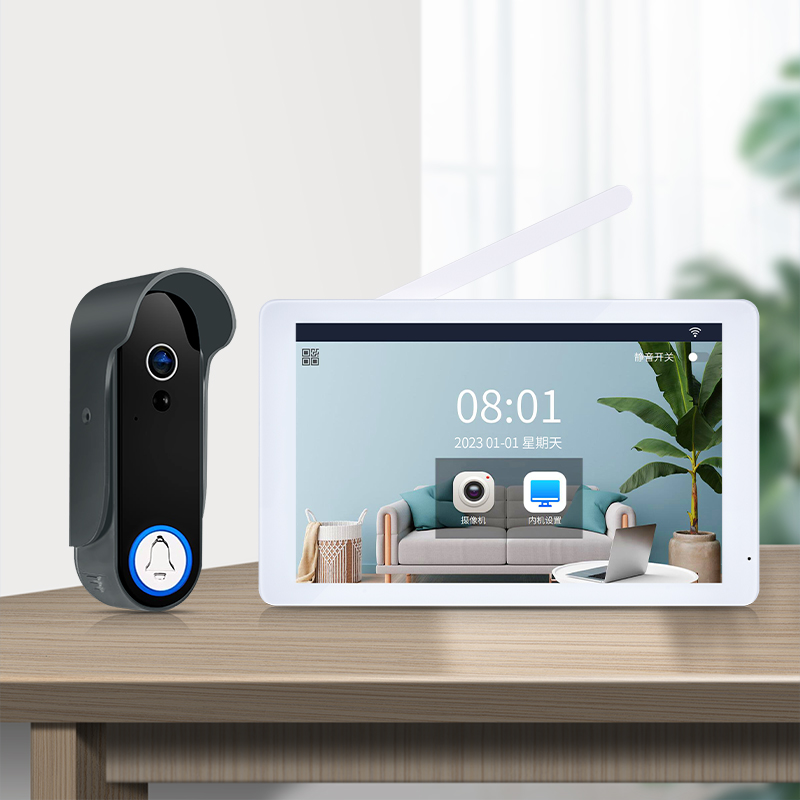Wireless Video Doorbell Indoor Unit: A Balance of Aesthetics and Functionality in Smart Home Security
Time:2024-10-11 16:05:50 ?? Views:24

With the rapid development of smart home technology, wireless video doorbells have become an essential part of home security and are gradually becoming a standard feature in modern households. Among them, the wireless video doorbell indoor unit serves as a bridge connecting users to the outdoor environment, with its structural design focusing not only on aesthetics but also on functionality. This article delves into the structure of wireless video doorbell indoor units, exploring aspects such as display screens, speakers, wireless signal receivers, and control buttons, aiming to reveal the design logic and technical secrets behind them.
I. Display Screen: The Core of Visual Experience
The high-definition display screen is one of the core components of the wireless video doorbell indoor unit, providing users with intuitive video display functionality. Modern wireless video doorbell indoor units typically adopt high-resolution displays, such as 1024x600 or 1280x800, to ensure that users can clearly see the image of visitors outside the door and the surrounding environment. Additionally, our company's wireless doorbells support touch operations, allowing users to answer calls, adjust volume, switch screens, and more through finger gestures like swiping and tapping on the screen, greatly enhancing the convenience and intuitiveness of operation.
The layout of the display screen is crucial for the user's viewing experience. To ensure that users can clearly view the video, the display screen is usually located in the center of the indoor unit and occupies a large area. The material and craftsmanship of the display screen also significantly impact its performance. High-quality displays often use glass materials with high light transmittance and low reflectivity to reduce light interference and reflection. Meanwhile, the frame and back of the display screen also undergo precise polishing and processing to ensure overall aesthetics and durability.
II. Speaker: The Transmitter of Sound
The speaker is an essential component in the wireless video doorbell indoor unit responsible for sound transmission. High-quality speakers not only ensure sound loudness and clarity but also enhance the comfort of conversations to a certain extent, ensuring that users can clearly hear the visitor's voice.
III. Wireless Signal Receiver: The Bridge of Communication
The wireless signal receiver is the key component for communication between the indoor and outdoor units. It is responsible for receiving audio and video signals and control signals sent by the outdoor unit, decoding them, and transmitting them to the display screen and speaker for processing. To achieve stable and efficient communication, modern wireless video doorbell indoor units typically adopt advanced wireless communication technologies such as Wi-Fi. These technologies offer advantages such as fast transmission speeds, wide coverage, and high stability, ensuring real-time transmission and stable reception of audio, video, and control signals.
Considering the aesthetic and concealment needs of the indoor unit, the wireless signal receiver usually adopts a hidden design. It is typically built into the interior of the indoor unit and connected to components such as the display screen and speaker through circuitry. This design not only reduces the risk of external interference and damage but also makes the indoor unit more streamlined and aesthetically pleasing.
IV. Control Buttons: The Interface for User Interaction
Control buttons serve as the interface for user interaction with the indoor unit. By pressing different buttons, users can answer and end calls, adjust volume, switch screens, and perform other functions. Our company's wireless video doorbell indoor units typically offer touch operation.
The microphone is an important component in the wireless video doorbell indoor unit responsible for sound capture. It captures the user's voice and converts it into digital audio signals for transmission. To ensure that users can clearly express themselves and reduce background noise interference, our company's wireless video doorbell indoor units adopt high-sensitivity, low-noise microphone designs and are equipped with intelligent noise reduction algorithms and echo cancellation technology.
The structural design of the wireless video doorbell indoor unit emphasizes both aesthetics and functionality. The various components work together to provide users with high-quality communication experiences and convenient security services. During the design process, designers fully consider user needs and preferences as well as the characteristics of the usage environment. In the future, with the continuous development of smart home technology and evolving user needs, the design of wireless video doorbell indoor units will continue to upgrade and improve. We can expect more intelligent, personalized, and user-friendly indoor unit products to emerge, bringing more convenience and fun to our lives.
Chinese Website——http://516ip.cn/